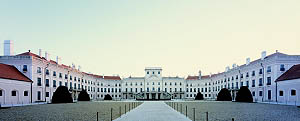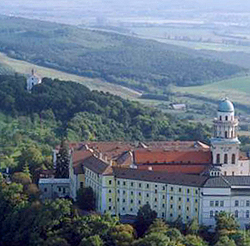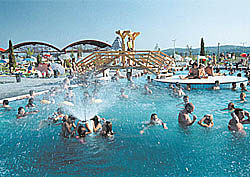Popular destinations nearby
Győr,
Sopron,
Bük,
Fertőd,
Kőszeg,
Mosonmagyaróvár,
Pannonhalma,
Szombathely,
Zalaegerszeg,
Celldömölk,
Dunasziget,
Fertőrákos,
Kapuvár,
Nagykanizsa,
Sárvár
|
The name of the region divided by hills, rivers and dead channels refers to the unity of three counties: Vas, Zala and Győr-Moson-Sopron.
In the north you can enjoy Lake Fertő, which is part of the World Heritage, and the unique wildlife of Rábaköz, but the landscape is also determined by the Danube arriving in the Small Plain: villages were established on its islands, its mortlakes and dead channels are the habitats for water lilies and reeds. In the west the Sopron hills are situated, the highest point of which is 558m, but other spots also offer beautiful views including the monadnocks arising from the valley of the river Marcal - although Ság and Kissomlyó are called mountains, in fact they are only hills by their size. From the hills of volcanic origin you can see up to the Balaton Highlands, but the delicious wines grown on the hills are worth tasting, too, or visitors can enjoy the thermal baths situated at the foot of the hills in Mesteri and Borgáta. Following the course of the river Rába and leaving the Sopron-Vas Plain and Kemeneshát, you can find Őrség not far from the Austrian and Slovenian borders. The inhabitants of the region with unique history and ethnography used to protect the border. The characteristic architectural style of the region and the buildings such as the 13th century churches in Hegyhátszentjakab, Őriszentpéter and Velemér still attract many visitors.
Lower hills are stretching in the region from Bakony: the Pannonhalma hills are the habitat for the hemerocallis and the pulsatilla, while in Écs you can find a primeval pine-wood, and in Felsőpéc - a primeval juniper grove. The Kőszeg hills lying near the border are famous for not only their natural values. Apart from the nature conservation area, it has protected architectural monuments such as the row of cellars in Cák or the Castle of Kőszeg and the Castle of St. Vid, which were important fortresses in the age of the Árpáds, as well as in the Middle Ages. One of the most beautiful parts of the Zala hills is Göcsej. The region is well-known for its folk culture: the huge forests provided plenty of materials for building log-houses. Cottages with thatched roofs have been preserved in many places, folk art is still living in the region.
The centre of the region is Győr attracting visitors with its baroque city centre, the Bishop's Castle and the thermal bath. Spa baths can be found in several other parts of West-Transdanubia including the famous bath of Bük with sulphurous water, or the baths in Sárvár, Zalaegerszeg and Kehidakustány. Those who are interested in history must visit the Esterházy Palaces in Fertőd and in Sopron, as well as the Jurisics castle in Kőszeg or the Roman relics in Fenékpuszta. It is worth wandering around the baroque streets and town-houses of Sopron, the Benedictine Abbey of Pannonhalma or the Szombathely section of the Roman Amber road. The lovers of nature can visit the region of Írott-kő, Szigetköz or the Mosoni Plain. During their stay they can even go hunting or riding a horse. As a relaxation, they can taste a glass of red wine from Kőszeg or a glass of olaszrizling from Zalaszentgrót. Lodgings in Western Hungary: Sights in Western Hungary: |
Western Hungary map nagyítása >>
in Western Hungary:
|
|
|
Hungary - Western Hungary |
|
|
|
||
|
Wednesday, 24. December 2025. - 13:46:32 |
||



